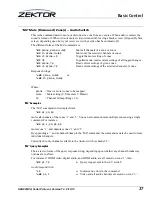
22
HDA800(V2) User Guide, Version 1.3, 9/12/13
Using The HDA800(V2)
For the most part there are fewer and fewer HDCP key issues with the newer HDMI products, and usu-
ally nothing needs to be done for the switch to work out of the box.
EDID
EDID is simple in concept. Each monitor or receiver contains a small data block that indicates what the
monitor’s or receiver’s capabilities are. When a source connects to a monitor, the monitor’s EDID is
read, and using this information, the source adjusts its output to match the capabilities of the monitor.
If a monitor can display 1080p and the source can output 1080p, then 1080p will be used. The same is
true for audio formats. The EDID will contain multiple resolutions that the monitor can display, and if
it can decode multiple audio formats, these formats will also be included in the EDID. The source will
compare the capabilities of the monitor, and it’s own capabilities, and choose the best video and audio
solution to send over the HDMI link.
This works well when a single source is connected to a single monitor. A matrix switch complicates
this a bit. What happens when two monitors are connected to the same source? Which EDID is used to
indicate what the monitors are capable of displaying? What if the monitors have different capabilities?
Traditionally this has been handle in a number of different ways. Some switches will use predefined
EDIDs that forces certain modes, like 1080p, 1080i or 720p and Dolby5.1 or PCM stereo audio, and
then assume all monitors can handle this.
Other solutions involve reading a single monitor's EDID and sending it all sources. Or a pass through
mode, where and single EDID is sent to a single source (in some switches this will prevent the viewing
of this source by any other zones).
There have been solutions that depend upon the order of switching, where the 1st zone to switch to a
source determines the EDID that is used. This is ideal if only one zone is switched to a source at a time.
A shared source can have a different EDIDs, depending upon switching order. This can lead to confu-
sion
“Why does Dolby5.1 only work sometimes?”,
and requires the user to disconnect all zones from a
source and reconnect them in a different order, depending upon what EDID features they want. This
can be disruptive to all viewers of a source, as well as hard to explain to the end user why this is neces-
sary. Or alternatively it requires custom driver programming at each install.
Our solution is to allow any combination of EDIDs to be combined and sent to any source. This allows
the flexibility of setting a source EDID to the capabilities of any single monitor / receiver, or any com-
bination of monitors / receivers. Each source can be sent a different combination of zone EDIDs. The
EDIDs sent to the source, are not switching order dependent, and since the EDIDs are based on zone
EDIDs, they are always valid.
By default, all the EDIDs of all zones (monitors and receivers) are read, and the lowest common fea-
tures of all the zones are combined into a single EDID, that is sent to all the sources. For instance, if all
the zones can receive Dolby5.1 audio, then the EDID will indicate that Dolby5.1 can be sent. If how-
ever even a single TV can only decode PCM stereo, the combined EDID will indicate to the all the
sources that only PCM stereo can be sent to any zone.
You can now use the
ESet
screen to combine the EDIDs of similar devices and send the combined
EDID to a source that will be associated with the devices. For instance all receivers can be combined
and sent to a Blu-ray or Cable box that will be used mostly for those receivers. This allows you to
enable Dolby5.1, or Dolby TrueHD, or any other features the receivers are capable of decoding.
Here are some common examples:
Scenario 1
You have a dedicated Blu-ray player to be used by a single hometheater receiver. You would use the
ESet
screen to set the EDID of the Blu-ray’s source to include only the zone of the hometheater
receiver. In this case, the EDID of the hometheater will be sent directly to the Blu-ray player and all
audio modes of the hometheater receiver will be available to the Blu-ray player. This will not prevent
Summary of Contents for HDA800
Page 1: ...HDMI Matrix Switches HDA800 HDA800 V2 User Guide ...
Page 2: ......
















































